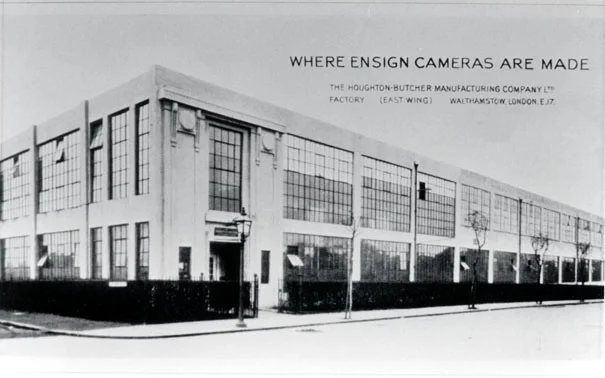Flying the flag for Ensign Cameras (at half mast)
Danny Coope tells the story of a now lost gem of Walthamstow’s architectural and industrial heritage.
In December 2013 Walthamstow lost its own Hoover building. If you saw the metal spring factory on Fulbourne Road opposite the entrance to Homebase, shrouded as it was by bland ugly grey cladding, you could be forgiven for overlooking its significance. The planning committee overlooked its significance too when permission to demolish it was approved last year in the face of a heated campaign to preserve it. What was the fuss all about?
Well, it was a 1920s palace of industry, a camera factory masquerading as a 1980s factory unit. It was originally designed by renowned architects Wallis, Gilbert & Partners together with a veritable greatest hits of Art Deco factory buldings including the egyptian-inspired Caribonum factory on Etloe Road, Leyton in 1920 for the manufacture of typewriter ribbons, ones for Wrigley (1927) and Firestone Tyres (1928) and yes the 1931 Hoover building in west London, and also the slightly less iconic Victoria Coach Station.
“there’s no point crying over spilt developer”
Anyway, let’s rewind time to 1837. There was a french painter called Louis Daguerre who had almost simultaneously invented photography at the same time as England’s William Fox Talbot was recording his bay window in Lacock Abbey for posterity. Daguerre’s technique involved coating small, polished metal plates with light sensitive chemicals. These are exposed to light and shade, channelled through a lens to burn an image of the sitter or scene onto the plate. Exposures of at least a minute were needed, which explains some of the stony faced antique portraits you see. Another downside to the process was that Daguerreotypes were one-offs. Fox Talbot on the other hand was already one step ahead developing negatives from which multiple copies could be reproduced. Commercial photography was born.
London-based glass merchants on High Holborn, Antoine Claudet (another frenchman) and George Houghton, diversified into this new industry when Claudet managed to obtain instructions and a license directly from Louis Daguerre to set up a studio while Houghton concentrated on photographic supplies. Claudet sped up exposure times with different chemicals to the relief of his sitters and even invented the safe darkroom ‘red light’. Claudet died in 1867 but Houghton’s son was already on board and by 1903 they’d expanded into the property next door and were now making their own-brand film called Ensign Daylight Loading photographic roll film. Incorporating other smaller camera makers trade was now so brisk for Houghton Ltd that they built a factory on Fulbourne Road in Walthamstow to fulfill demand, adding the Ensign brand to their range of cameras. Joining forces with cinematic camera and projector manufacturer W Butcher staffing levels reached over 700, making it Britain’s (or as the publicity boasted the Empire’s) biggest camera factory. The original 1920 building was designed by the aforementioned Wallis, Gilbert & Partners and was 280 ft wide and 75 ft deep. Constructed of reinforced concrete and featuring small-paned metal windows with brick spandrels, it was built initially as a single storey with four first floor offices, but later an entire first floor was added to increase production space. Even though the High Holborn headquarters were destroyed by bombing during WW2 the factory played its part in the war effort producing items for the armed forces. Sadly after the war demand had waned and despite various mergers, foreign imports finally took their toll and Ensign production moved to Clapham Common in 1955. It was the end of an era.
Wallis, Gilbert & Partners’ Caribonum factory in Leyton was pulled down in 1980 for redevelopment, the same year their Firestone Tyre factory building on the Great West Road was hastily demolished before it could be listed. And sadly, on our watch, the Ensign factory has been pulled down too, but it’s in good company you might say. But the brand needn’t be forgotten, Ensign cameras live on in second-hand world. Look out for something like an Ensign Selfix or Ranger Special, you can pick one up for less than £50. These cameras take what are known as ‘120’ rolls of film which is still being made and processed today. You can even buy it in colour! You’ll only get about a dozen photos per roll (with developing costs from £6) but once you get the knack of using these beautiful, Walthamstow-made cameras every photo you take will be imbued with a true romance and lo-fi quality that Instagram can only mimic.
The factory is gone, there’s no point crying over spilt developer (ironic pun intended) but a little bit of vintage Ensign technology could continue to fill our analogue family albums for years yet.
Sources: Form and Fancy: Factories and Factory Buildings by Wallis, Gilbert & Partners, 1916-1939 by Joan S. Skinner; ensign.demon.co.uk; earlyphotography.co.uk; camerapedia.wikia.com
“Walthamstow lost its own Hoover building”

